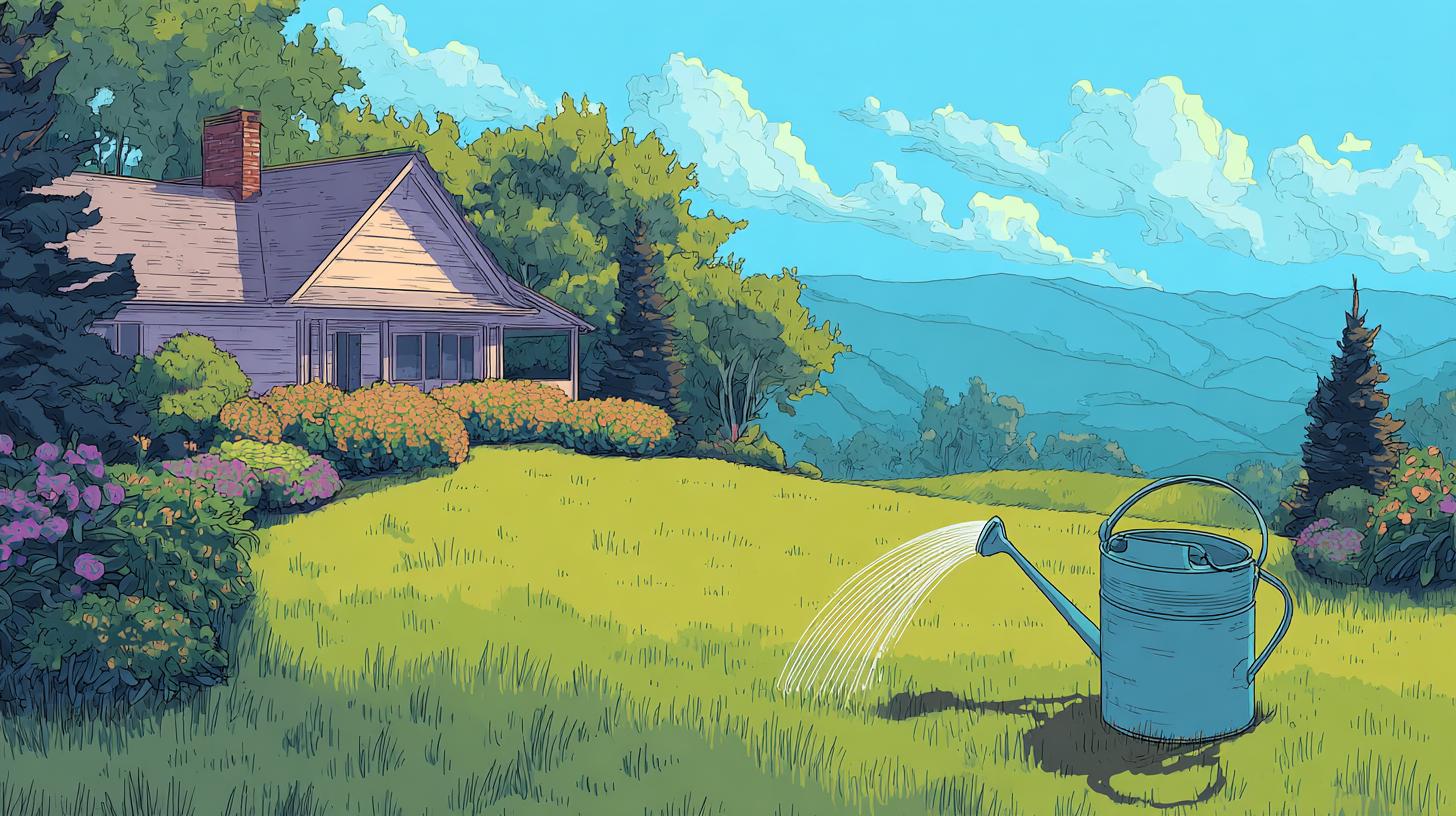The Quick Answer
You can water your lawn without a hose using bucket systems, watering cans, or setting up a simple rain barrel collection system. The key is creating a routine that's efficient and doesn't strain your back or budget.
What We'll Cover
Why This Matters
Many homeowners find themselves facing hose restrictions, broken outdoor spigots, or new homes where the water hookup isn't ready yet. It's common to see people struggle with heavy buckets or waste time making countless trips from indoor faucets. Without a proper system, you might spend hours watering what should take 30 minutes, or worse—watch your grass turn brown while waiting for repairs. The right approach can save your lawn and your sanity until you get your regular watering system sorted out.
Simple Bucket and Watering Can Methods
The most straightforward approach starts with a 5-gallon bucket and a standard watering can. Fill your bucket from any indoor tap, then use smaller containers to transport water to your lawn. A typical 2-gallon watering can covers about 50 square feet of grass when you're spot-watering dry patches.
Position multiple buckets around your yard the night before watering. This spreads out the work and creates staging areas. Fill them early morning when it's cool, then you can water throughout the day without the heavy lifting all at once.
What Actually Works
When carrying water gets tiring, a watering wand changes everything. The GORILLA EASY CONNECT Garden Watering Wand with Shut-Off Valve extends your reach significantly, lets you control the flow precisely, and reduces the number of trips you need to make from your water source.
For larger areas, consider using a wheelbarrow to transport multiple containers at once. You can fit three 5-gallon buckets in most wheelbarrows, giving you 15 gallons of water per trip. This approach works especially well for slopes or areas far from your house.
"I thought I'd kill my lawn when our sprinkler system broke in July, but the bucket method actually let me target the areas that needed water most. My grass looked better than ever."
- Maria from Arizona
Setting Up a Rain Collection System
Rain barrels offer the most sustainable long-term solution when you can't use a traditional hose. A standard rain barrel collects about 600 gallons from just one inch of rainfall on a 1,000 square foot roof. That's enough water for several weeks of lawn maintenance.
Position your collection barrel under a downspout or create a simple funnel system using tarps. Even apartment dwellers can set up small collection containers on balconies or patios. The key is maximizing your collection surface area during rain events.
What Actually Works
A proper rain barrel makes all the difference in efficiency. The RTS Home Accents 50-Gallon Rain Water Collection Barrel with Brass Spigot provides serious water storage, includes a reliable spigot for easy access, and connects directly to your existing downspouts without complicated modifications.
Connect multiple barrels together for increased storage capacity. Use a simple siphon system or flexible tubing to link them. This gives you backup water during dry spells and means you're not scrambling to empty full barrels before the next storm.
💡 Pro Tip: Add a few drops of vegetable oil to collected rainwater to prevent mosquito breeding, or cover your containers with fine mesh screens.
Smart Scheduling and Water Conservation
Without unlimited hose access, timing becomes critical. Water early morning (6-8 AM) or late evening (6-8 PM) to minimize evaporation. You'll use 30% less water during these cooler hours compared to midday watering.
Focus on deep, infrequent watering rather than daily sprinkles. Grass needs about 1 inch of water per week, but it's better delivered in 2-3 sessions rather than daily light watering. This approach actually strengthens root systems and makes your lawn more drought-resistant.
What Actually Works
Managing watering schedules manually gets overwhelming fast. The Orbit 62061Z Single-Outlet Hose Watering Timer automates your rain barrel or bucket system perfectly, ensures consistent timing even when you're busy, and prevents overwatering that wastes your collected water.
Prioritize your lawn areas based on visibility and foot traffic. Front yard areas and main pathways get first priority for your limited water supply. Back corner sections can often handle slightly less water without anyone noticing.
"Once I started tracking how much water I actually used, I realized I was overwatering with the hose anyway. The bucket method taught me to be more efficient."
- Tom from Michigan
Creating an Efficient Watering Route
Map out your watering route like a mail carrier plans their delivery. Start with areas closest to your water source, then work outward in logical sections. This prevents doubling back and carrying water unnecessarily far.
Mark problem areas with small flags or stakes. These spots—usually under trees, on slopes, or in full sun—need extra attention and should be your first stops when water supplies are limited. Address these areas every watering session, then rotate through other sections.
Create staging areas throughout your yard using decorative containers or buckets. Position them strategically so you're never more than 20 feet from a water source. This system works especially well for larger properties where carrying water long distances becomes impractical.
💡 Pro Tip: Use a small wagon or garden cart to transport multiple containers simultaneously. You can water three times the area in the same number of trips.
Consider installing temporary soaker hoses that you can fill manually. Lay them in sections, pour water into one end, and let gravity distribute it evenly. This method covers more ground with less effort than hand-watering every square foot.
Troubleshooting Common Challenges
The biggest challenge most people face is water weight. Five gallons weighs 40 pounds, which gets heavy fast. Instead of fighting this, work with smaller quantities more frequently. Two-gallon trips are much more manageable and reduce strain on your back and arms.
Uneven watering patterns create brown spots and overwatered areas. Combat this by using containers with measured amounts—always use the same container for each area so you know exactly how much water you're applying. A 1-gallon container covers about 25 square feet of established lawn.
When water pressure is low from your collection system, elevate your storage containers. Every foot of height increases water pressure naturally. Place rain barrels on sturdy platforms or use gravity-fed systems from second-story locations when possible.
Algae growth in stored water becomes problematic in warm weather. Keep containers covered and in shaded areas when possible. Add a capful of white vinegar per 5 gallons to prevent algae without harming your grass. Replace stored water weekly during hot weather.
For persistent dry spots that seem to resist manual watering, the soil may be compacted or water-repellent. Poke holes with a screwdriver every 6 inches in these areas before watering. This helps water penetrate rather than running off to other areas.
Mistakes to Avoid
- Watering too frequently with small amounts: This creates shallow root systems and actually makes drought damage worse.
- Using dirty containers: Soap residue, chemicals, or debris in your water containers can damage grass and soil.
- Ignoring weather forecasts: Don't water right before rain storms—you'll waste effort and risk overwatering your lawn.
Bringing It All Together
Watering without a hose requires more planning but often results in healthier, more efficiently watered lawns. You'll develop a better understanding of your yard's actual water needs.
Start with the bucket method today, then add rain collection as you see what works best for your space. Your lawn will thank you, and you might discover you prefer this more targeted approach.


